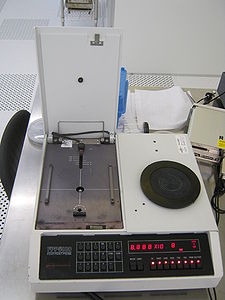Specific Process Knowledge/Characterization/Four-Point Probe
Feedback to this page: click here
Four-Point Probe

The set-up of the four point probe is four the tungsten carbide electrodes/probes.The power source (DC) sends a current through the two outer electrodes. A digital voltage meter (DVM) measures the potential drop between the two inner electrodes.
The sheet resistance can then be calculated using the equation below:
(Unit ohms/square)
This equation is only valid if: i) the material being tested is no thicker than 40% of the spacing between the probes, and ii) the lateral size of the sample is sufficiently large. If this is not the case, then geometric correction factors are needed to account for the size, shape, and thickness of the sample. Bulk resistivity for wafers and films = sheet resistance x wafer thickness in cm (Unit ohm.cm) Bulk resistivity for a semi-infinite volume = 2 x π x S x V/I where is S is the probe spacing in cm (Unit ohm.cm) A sample is usually defined as a “semi-infinite volume” if it extends to infinity in all directions below a plane on which four probes are located.
Note:
Volume Resistivity = Volume Resistance = Bulk Resistivity = Bulk Resistance
Sheet Resistivity = Sheet Resistance = Surface Resistivity = Surface Resistance
There are two four point probes at Nanolab. Four point probe from Jandel is located inside the cleanroom(D-3) and Four-Point Probe from Veeco is now located in the basement(346-904).
Four-Point Probe from Jandel

The Four point probe is manufactured by Jandel Engineering Limited and using Jandel probe head and the RM3000+ Test Unit which can supply constant current between 10nA and 99.99mA, and measure voltage from 0.01mV to 1250mV.
For sheet resistance measurements, the quoted range is 1 milliohm/square to 5x108 ohms/square. Measurements outside this range are possible but with possible reduced accuracy. For volume (bulk) resistivity measurements, the quoted range is 1 milliohm.cm to 1x106 ohm.cm. Measurements outside of this range may be possible but will depend on sample type e.g. whether the sample is a thin layer.
Multiposition Probe stand can measure on wafers up to 200mm diameter. The Θ movement clicks in four positions at 90 degrees and the linear movement in up to 10 positions giving repeat placement accuracy of +/- 1mm.
Four-Point Probe from Veeco
The Four-Point Probe is a Veeco FPP-5000 for I/V measurement. The main purpose is to measure resistance and resistivity on a 4" silicon wafer. But can also be used to find thickness of thin layers or test if is a N- or P-type wafer.

It works only for 4" wafers because a special holder is need.
The user manual, technical information and contact information can be found in LabManager:
| Purpose | Resistance and resistivity measurement | |
|---|---|---|
| Process parameter range | Process Temperature |
|
| Process pressure |
| |
| Substrates | Batch size |
|
| Substrate material allowed |
|
